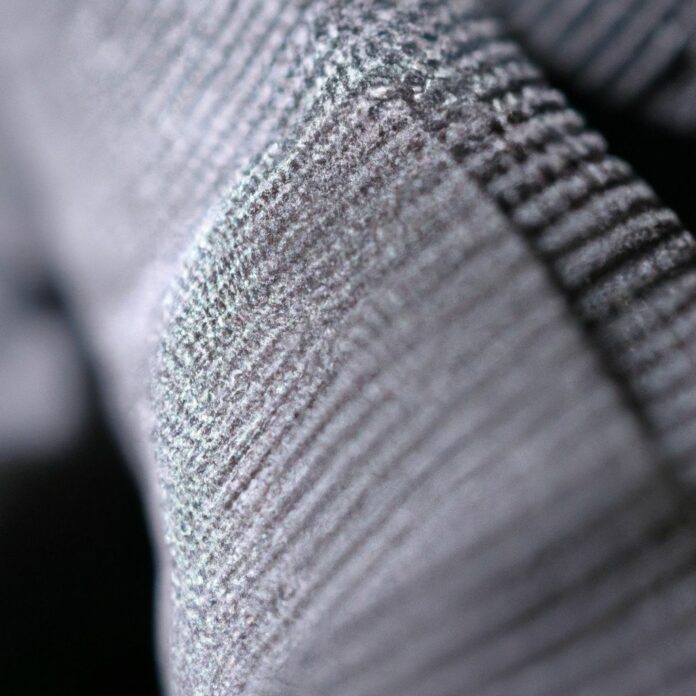Bulletproof vests are a crucial piece of protective equipment used by military personnel, law enforcement officers, and individuals in high-risk professions.
They are designed to absorb and distribute the impact of bullets, reducing the likelihood of injury or fatality. Understanding the materials used in bulletproof vests is essential to comprehend their effectiveness and functionality.
Understanding how bulletproof vests work is also crucial. By combining different layers of materials, bulletproof vests can counteract the force and energy generated by bullets, dispersing it across a larger area to minimize injury.
The effectiveness of bulletproof vests is categorized into different levels based on their ability to stop specific calibers and velocities of bullets.
What are Bulletproof Vests Made Of?
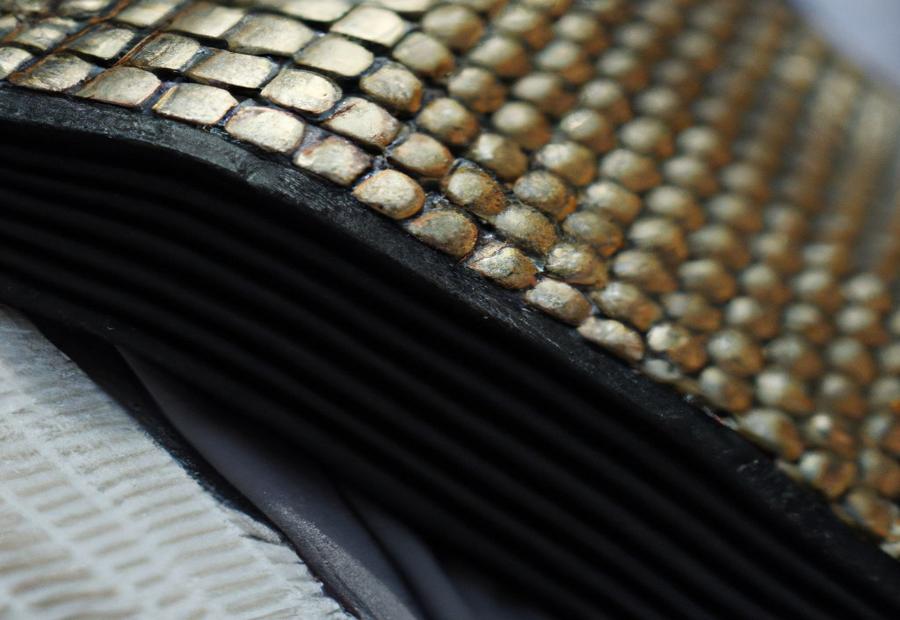
Photo Credits: Paintballbuzz.Com by Lawrence Hall
Bulletproof vests provide a crucial layer of protection for those in high-risk professions, but have you ever wondered what these life-saving garments are actually made of?
In this section, we will uncover the materials that constitute bulletproof vests. From the renowned strength of Kevlar and Spectra Shield to the cutting-edge technologies of Dyneema and Twaron, we’ll explore the innovative fabrics that help shield us from harm.
Additionally, we’ll delve into the use of Gold Flex, ceramic plates, and steel plates, revealing the diverse range of materials employed in the construction of these vital defense tools. Get ready to discover the secrets behind bulletproof vest composition!
Kevlar
Kevlar is a commonly used material in bulletproof vests because of its high strength and durability.
- Kevlar is a synthetic fiber that was developed by DuPont in the 1960s.
- It is made from long chains of polymers that are aligned in a parallel manner to create a strong and rigid structure.
- Kevlar is five times stronger than steel on an equal weight basis, making it an excellent choice for bulletproof vests.
- It is resistant to impact and penetration, effectively stopping bullets and other projectiles.
- Kevlar is also lightweight and flexible, allowing for ease of movement while wearing a bulletproof vest.
Fact: Kevlar is not only used in bulletproof vests but also has various other applications, such as in tires, cables, and high-performance sports equipment. Its strength and versatility make it a valuable material in many industries.
Spectra Shield
Spectra Shield is a high-performance polyethylene material used in the construction of bulletproof vests. It is created using a patented gel-spinning process, resulting in a fiber with exceptional strength and resistance to impact.
When incorporated into a bulletproof vest, Spectra Shield provides reliable protection against various types of ballistic threats.
| Material | Properties |
|---|---|
| Spectra Shield | High-performance polyethylene material. |
| Strength | Exceptional strength and resistance to impact. |
| Protection | Reliable protection against ballistic threats. |
Pro-tip: When considering a bulletproof vest, it is vital to understand the materials used in its construction. Spectra Shield, with its high-performance properties, is an excellent choice for those seeking reliable protection.
Its strength and resistance to impact make it a valuable component in bulletproof vests, providing peace of mind in dangerous situations.
Dyneema
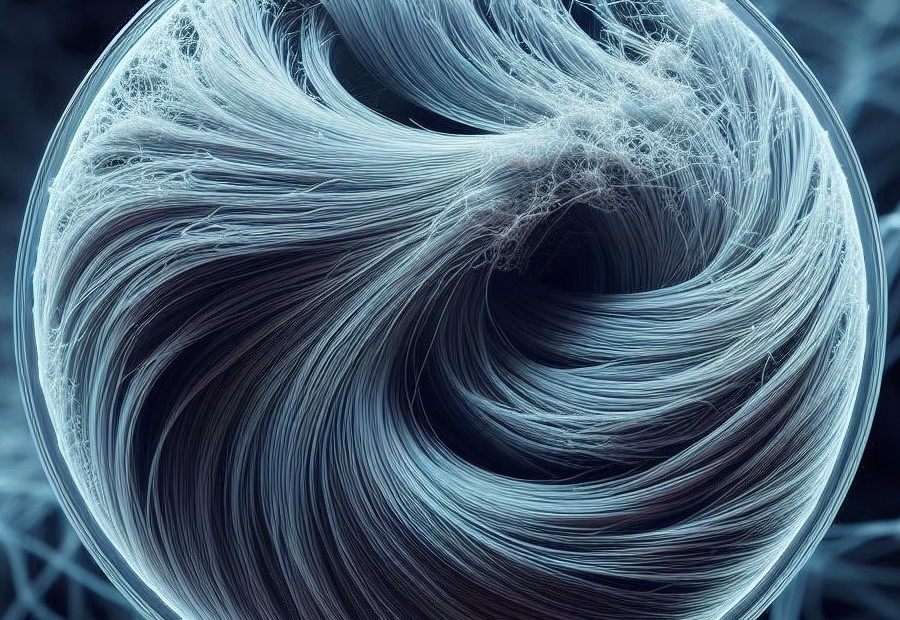
| Dyneema | Dyneema is a high-performance polyethylene fiber that is used in the construction of bulletproof vests. It is one of the strongest and lightest fibers in the world, making it an ideal material for protective gear. Dyneema has a tensile strength that is 15 times stronger than steel, yet it is much lighter in weight. This allows for greater mobility and comfort for the wearer of the bulletproof vest. |
Pro-tip: When considering a bulletproof vest, look for one that utilizes Dyneema. Its strength and weight properties make it an excellent choice for providing protection without sacrificing comfort and maneuverability.
Twaron
Twaron is a high-performance synthetic fiber used in the production of bulletproof vests. Its exceptional strength and durability make it an ideal material for protective gear.
Twaron is five times stronger than steel on an equal weight basis, yet it is lightweight and flexible, providing wearers with comfort and ease of movement.
Bulletproof vests made from Twaron fibers offer reliable protection against various ballistic threats. They provide excellent resistance to punctures and impact, ensuring the wearer’s safety in dangerous situations.
Twaron vests are commonly used by law enforcement officers, military personnel, and security professionals.
The effectiveness of Twaron in stopping bullets lies in its ability to absorb and disperse the energy upon impact.
When a bullet strikes the vest, the Twaron fibers work together to distribute the force over a larger surface area, preventing the projectile from penetrating the vest. This mechanism greatly reduces the risk of injury.
It is important to note that the level of protection provided by a bulletproof vest depends not only on the material used but also on the design and construction of the vest.
Different levels of bullet resistance are available, ranging from Level I to Level IV. These levels determine the type of ammunition the vest can withstand.
Gold Flex
Gold Flex is a material used in the production of bulletproof vests due to its exceptional properties.
- Gold Flex is a type of fabric that is woven with strong and flexible golden fibers.
- The use of Gold Flex in bulletproof vests helps to enhance their protective capabilities.
- Gold Flex is known for its high strength-to-weight ratio, making it lightweight yet durable.
- Bulletproof vests made with Gold Flex offer excellent resistance to penetration by bullets or projectiles.
- The golden fibers in Gold Flex are designed to absorb and distribute the force of impact, reducing the risk of injury.
- Gold Flex is commonly used in combination with other materials, such as Kevlar or Spectra Shield, to create multi-layered vests for increased protection.
- Bulletproof vests incorporating Gold Flex are often used by military personnel, law enforcement officers, and security professionals.
- Gold Flex is also resistant to moisture and UV rays, making it suitable for various environmental conditions.
- When choosing a bulletproof vest, consider the presence of Gold Flex as a desirable feature for enhanced protection.
Keep in mind that bulletproof vests made with Gold Flex are designed to provide protection against specific types of ammunition and have different levels of ballistic resistance. It is crucial to select the appropriate level of protection based on the anticipated threats.
Ceramic Plates
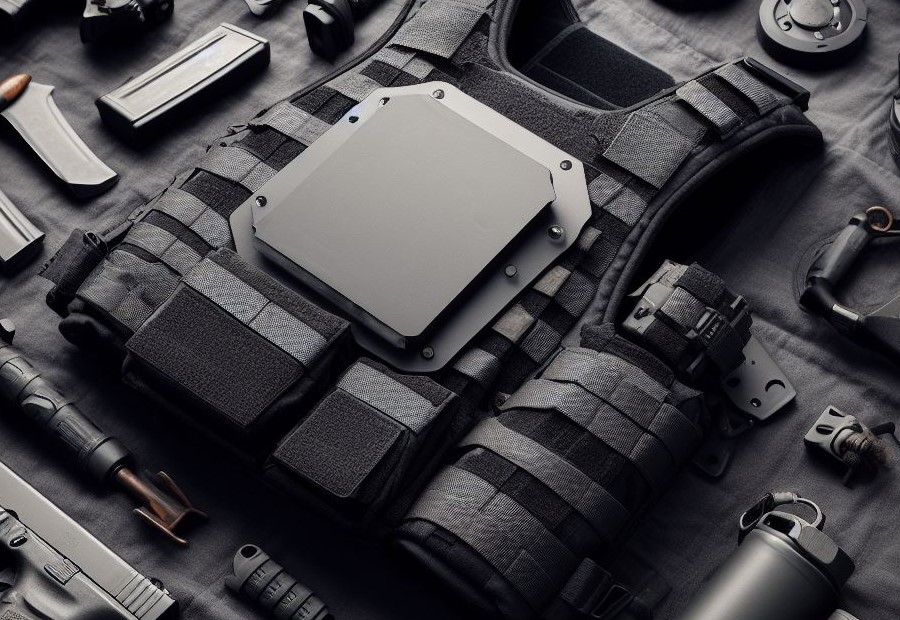
Ceramic plates, also known as bulletproof vests components, play a vital role in providing effective protection against bullets.
These plates are constructed using durable materials, such as alumina, boron carbide, and silicon carbide, which are renowned for their excellent hardness and toughness.
When it comes to bullet impact, ceramic plates are designed to absorb and disperse the energy, thus reducing the risk of penetration. Upon impact, the hard ceramics fracture, dissipating the force generated by the bullet.
To attain additional protection against high-velocity projectiles, ceramic plates are typically used together with soft armor vests. These plates are inserted into pockets located at the front and back of the vest.
Furthermore, ceramic plates are capable of safeguarding against various types of ammunition, including pistol rounds and rifle rounds. Ceramic plates with higher-level protection demonstrate superior stopping power against more powerful ammunition.
One of the notable advantages of ceramic plates is their lightweight nature, making them more comfortable for the wearer. Additionally, these plates possess resistance against corrosion and offer a long lifespan.
Steel Plates
When it comes to bulletproof vests, steel plates are one of the materials used to provide protection against projectiles. These plates are made of strong and durable steel that can withstand high-velocity impacts.
| Material | Steel Plates |
| Strength | High-velocity impact resistance |
| Role | Providing protection against projectiles |
| Effectiveness | Highly effective in stopping bullets |
Steel plates are known for their ability to stop bullets and offer reliable protection. They are commonly used in conjunction with other materials, such as Kevlar, to create multi-layered bulletproof vests that provide comprehensive defense.
Steel plates offer a high level of durability and can withstand repeated impacts, making them suitable for use in various situations where ballistic protection is required.
It’s important to note that the weight of steel plates can vary depending on thickness and size, so it’s crucial to consider both comfort and protection when choosing a bulletproof vest with steel plates.
How Do Bulletproof Vests Work?
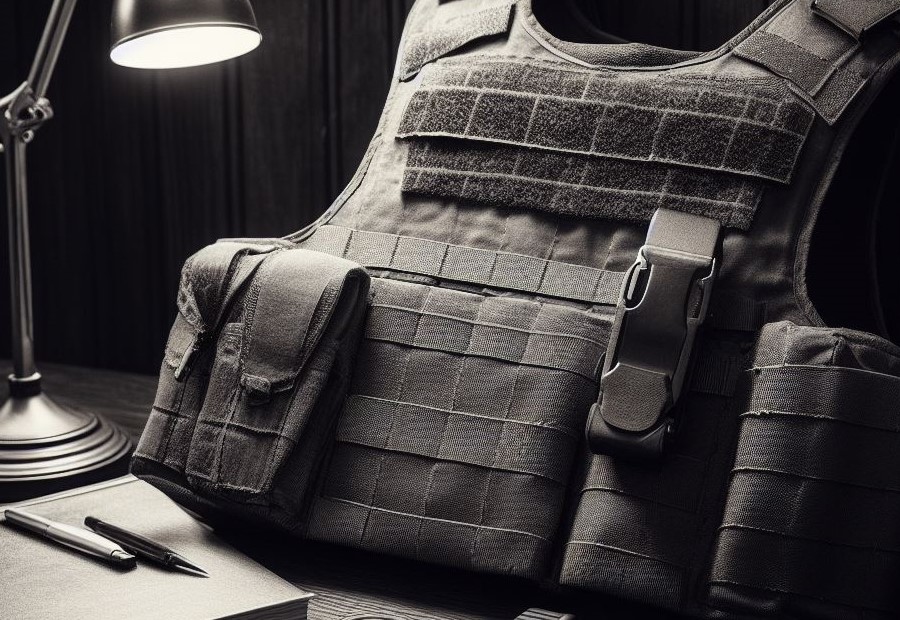
Bulletproof vests work by absorbing and dispersing the force of a bullet upon impact. They are made with layers of strong and resistant materials such as Kevlar or Dyneema, which are lightweight yet incredibly tough.
When a bullet hits the vest, the layers of material catch and spread out the force, preventing it from penetrating the body. These vests are designed to protect vital organs and reduce the risk of injury, although they cannot guarantee complete protection against all bullets or firearms.
A true story that demonstrates the effectiveness of bulletproof vests occurred in 2014.
During a bank robbery in California, a police officer named Brian Murphy was shot multiple times by an assailant armed with a high-powered rifle.
Despite sustaining serious injuries, Murphy survived the encounter thanks to his bulletproof vest. The vest absorbed the impact of the bullets and helped to save his life.
This story serves as a powerful reminder of the importance of properly constructed and tested bulletproof vests in providing protection for law enforcement officers and others who find themselves in harm’s way.
Levels of Bulletproof Vests
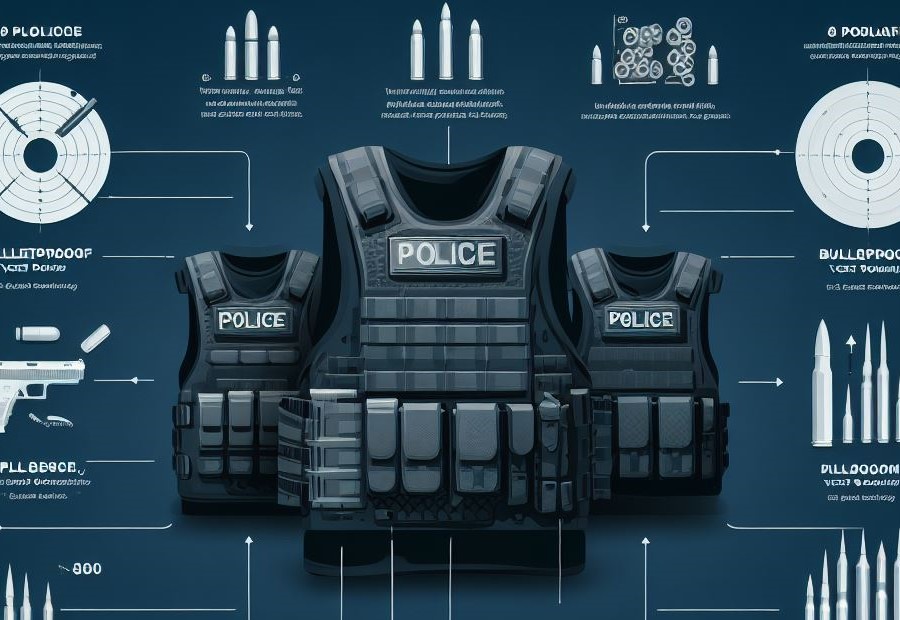
When it comes to bulletproof vests, understanding the different levels is essential. In this section, we’ll explore the various levels of bulletproof vests, ranging from Level I to Level IV.
Discover the varying degrees of protection offered by each level, providing insight into the capabilities and effectiveness of these life-saving garments.
So, let’s dive in and uncover the crucial distinctions between each level of bulletproof vests.
Level I
Level I bulletproof vests provide protection against low-velocity handgun rounds. They are designed to withstand bullets with a minimum speed of up to 140 m/s (459 ft/s). These vests offer coverage on both the front and back, with a minimum of 16 square inches of protection area for each.
Level I vests are suitable for situations where there is a lower threat level and the primary concern is protection against handguns.
Level IIA
In the Level IIA category, bulletproof vests offer protection against 9mm FMJ RN bullets and .40 S&W FMJ bullets, with velocities ranging from 1,175 to 1,380 feet per second.
These vests are made of soft armor materials like Kevlar, Twaron, Spectra Shield, or Gold Flex.
They are frequently utilized by law enforcement officers and security personnel due to their ability to provide sufficient protection against common handgun threats in everyday situations.
Level IIA vests prioritize the wearer’s comfort and flexibility while ensuring reliable protection through the incorporation of these advanced materials.
Level II
| Level II | ||
| Protection Level | 9mm FMJ RN | .357 Magnum JSP |
| Minimum Velocity (feet per second) | 1225 | 1250 |
| Required Kinetic Energy (foot-pounds) | 358 | 575 |
| Effective in Stopping | Handguns | Handguns |
In the level II category of bulletproof vests, they offer protection against 9mm FMJ RN and .357 Magnum JSP handgun ammunition.
The minimum velocity at which the 9mm round can be travelling is 1225 feet per second, while for the .357 Magnum round, it must be at least 1250 feet per second.
The required kinetic energy for the 9mm round is 358 foot-pounds, whereas for the .357 Magnum round, it is 575 foot-pounds. Level II vests are effective in stopping handgun ammunition.
Bulletproof vests have come a long way in providing personal protection. From their origins in medieval times to the modern materials used today, advances in technology have helped to enhance their effectiveness.
The development of level II vests, along with other levels, has played a crucial role in safeguarding individuals in law enforcement, military, and other dangerous professions.
Throughout history, the need for body armor has been evident, as people have sought ways to protect themselves from projectiles and other forms of armed attacks.
Today, bulletproof vests continue to evolve and adapt to meet the ever-changing threats faced by individuals in various fields.
This progress highlights the commitment to providing superior protection and the ongoing pursuit of improving safety for those who put themselves in harm’s way.
By understanding the different levels of protection offered by bulletproof vests and making informed decisions, individuals can choose the appropriate level of defense based on their specific needs and potential threats they may encounter.
Level IIIA
Bulletproof vests that offer a high level of protection against various handgun threats are known as Level IIIA vests.
These vests are designed to provide the following key features:
– High protection: Level IIIA vests have the capability to stop bullets from most common handguns, including 9mm, .40 S&W, .45 ACP, and .44 Magnum. They provide protection against both full metal jacket (FMJ) and jacketed hollow point (JHP) ammunition.
– Flexible and lightweight: Level IIIA vests are specifically designed to be lightweight and flexible, ensuring optimum mobility and comfort for the wearer. This allows for easy movement during tactical operations or everyday wear.
– Soft armor construction: Level IIIA vests are typically constructed with layers of advanced ballistic materials, such as Kevlar or Spectra Shield. These materials are specifically designed to absorb and dissipate the energy of the bullet upon impact.
– NIJ certification: Level IIIA vests undergo rigorous testing and certification by the National Institute of Justice (NIJ). This ensures that they meet stringent safety standards and provide reliable protection against specific threats.
– Compatibility with additional plates: Level IIIA vests can often be upgraded with additional ballistic plates to provide protection against higher-level threats, such as rifle rounds. This versatility allows users to customize their level of protection as needed.
– Comfort and adjustability: Level IIIA vests are designed with adjustable straps and closures to ensure a secure and comfortable fit for different body types. This allows for extended wear without compromising mobility or comfort.
Overall, Level IIIA vests are an excellent choice for law enforcement officers, military personnel, and individuals seeking effective personal protection against handgun threats.
It’s always advisable to consult with a certified professional to determine the appropriate level of protection for specific circumstances.
Level III
Level III bulletproof vests provide protection against most handgun rounds, including 9mm and .44 Magnum. These vests are designed to stop projectiles fired from handguns and do not offer protection against rifle rounds.
Level III vests are classified based on the National Institute of Justice (NIJ) Standard-0101.06. Some examples of Level III bulletproof vests include Dragon Skin and those that meet the NIJ Standard-0101.06 Level III requirements.
These vests are made with strong materials to stop handgun rounds effectively.
Level IV
| Level IV | |
|
Protection Level
|
Description
|
| IV | This level provides maximum protection against high-velocity rifle rounds and armor-piercing ammunition. |
|
Materials Used
|
Description
|
| Hard Armor Plates | Hard armor plates made of ceramic, polyethylene, or steel are used to stop rifle bullets. These materials are designed to absorb and disperse the force of the bullet, decreasing its penetrative power. |
|
Weight
|
Description
|
| 10-12 pounds (4.5-5.4 kilograms) | Level IV bulletproof vests typically weigh around 10 to 12 pounds, making them heavier than lower-level vests due to the added protection against rifle rounds. |
|
Usage
|
Description
|
| Military, Law Enforcement | Level IV vests are commonly used by military personnel and law enforcement officers who are exposed to high-risk situations where rifle fire is a significant threat. |
Frequently Asked Questions
What materials are bulletproof vests made of?
Bulletproof vests are made of layers of high tensile strength fibers, specifically ultra high molecular weight polyethylene (UHMWPE) or aramid fibers like Dyneema and Kevlar.
What is UHMWPE and how is it used in bulletproof vests?
UHMWPE stands for ultra high molecular weight polyethylene, which is a very strong material resistant to ballistic, sharp-edged, and pointed instruments. It is lightweight, wearable, and used as the main material in bulletproof vests.
What is the difference between UHMWPE and aramid fibers?
UHMWPE, such as Dyneema, is lightweight, has high wear resistance, and is up to 15 times stronger than steel. On the other hand, aramid fibers like Kevlar are known for their strength, flexibility, and light weight.
Can bulletproof vests protect against rifle fire?
Yes, bulletproof vests can offer protection against rifle fire. Level III and IV vests, which require armored plates made of materials like ceramic, Dyneema, or steel, are designed to protect against rifle fire.
What are the different levels of protection for bulletproof vests?
The National Institute of Justice recognizes five levels of protection for bulletproof vests: Levels IIA, II, IIIA, III, and IV. Level IIA and II vests provide the least amount of protection, while Level IIIA offers the most protection against handgun rounds. Levels III and IV can protect against rifle fire.
Are there different international standards for bulletproof vests?
Yes, there are different international standards for bulletproof vests, such as the American NIJ, German Standard, and British Standard. These standards define the level of protection and performance requirements for soft body armor.

